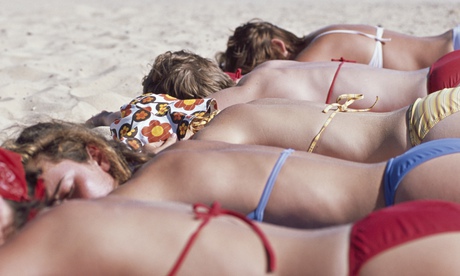
‘In the 1920s, sunbathing 1st became a public overall health crusade.’ Photograph: G & M David de Lossy/Getty Photos
The skies clear. The temperatures rise. For a couple of days it seems to be and feels like summer time. And proper on cue, along with the packed parks and pink skins, come the acres of stories about the huge yellow thing appearing to make every person pleased.
Final week a new Cancer Investigation study exposed that even factor 50 suncream can’t promise protection against malignant melanoma. And on Tuesday, the Daily Mail reported that “image-conscious” youngsters as younger as nine would go to any length to copy perma-tan celebrities this kind of as Cheryl Cole. Half of the one,000 under-16s polled in the Superdrug-conducted survey confessed to “lying to their parents about [sporting] sunscreen”. Although “other tricks incorporated rolling up the arms and legs of their college uniform, and sporting as few garments as achievable”. Unshocked to understand that the younger fib to their people, or flout uniform rules, I discern a a lot more urgent and revealing tendency. The recurrent and increasing depiction of the sun as Public Well being Enemy No 1.
As the author of the Cancer Study research put it, the findings reveal “how harmful this cancer-creating agent is”. And while we can not flip off the sun, or get in touch with it to account, somebody surely have to be blamed. The Mail piece clearly reveals who. For despite the fact that 64% mentioned they wanted a tan since they “just felt more healthy”, it is the picture-aware 31% copying the B-listing bronzers who grab the headline and result in this kind of concern. From Coco Chanel to Katie Price tag, it is the fashionable and glamorous who have taken the rap for inventing and encouraging this harmful pursuit.
“Cover up” is the advice of the overall health authorities. And “cover up” is the very phrase I would hurl accusatively back. For the accurate history of sunbathing reveals just how ironic that guidance is. The fashionable did not invent the craze for sunbathing, as we’ve been encouraged to think. In reality, they adopted tanning relatively late. English Vogue did not characteristic tanned models till July 1927, practically 50 years following sunbathing started becoming practised in the most unlikely quarters.
No, the history of sunbathing starts not with the wealthy and glamorous, but the bad and desperate. And it was actively promoted, not in the pages of the fashion press, but in healthcare journals and public well being pamphlets – by the very counterparts of those who condemn the practice these days. Medication developed our sun addiction – a monster that refuses to go back into the lab.
I will briefly sketch in the history, and debunk some of the persistent myths. Sunbathing as a aware activity emerged in the direction of the end of the 19th century principally as a remedy for tuberculosis of the skin (lupus vulgaris). In 1903 one particular of the pioneers of this practice, the Danish physician Niels R Finsen, won the Nobel prize for medication for his surgical use of ultra violet light. But he was not alone in extolling the sun’s curative or dietary characteristics. John Harvey Kellogg, the inventor of Corn Flakes, also invented the sunbed, patenting his very first gadget in 1896 – by royal appointment no significantly less, as Edward VII apparently kept one particular at Windsor Castle for his gout.
In the 1920s, sunbathing initial became a public overall health crusade (this time selling it). The discovery of Vitamin D by way of UV light in 1922 triggered the lobbying for sunbaths and sunbeds to support avoid rickets in urban populations. Public lidos were established especially to offer city dwellers with a area to sunbathe. And last but not least, irony of ironies, special sunbathing clinics had been set up for youngsters to have winter sunlamp therapies. If the younger are now considered specifically vulnerable to the stylish allure of the suntan, history gives this tendency a entire various complexion.
The jet set caught the craze extremely late, and only simply because overall health and physical culture came into vogue in the late 1920s. Ahead of the bright younger factors sported tans, they have been the protect of consumptives, the malnourished, well being obsessives and nudists. The first nudist clubs have been called Sun Clubs, dedicated to the excellent and healthy outdoors.
Viewpoint has come complete circle. The experts altered their minds, and modified their message, with out as soon as acknowledging their contribution. Trend continues to carry the can. The sun, meanwhile, continues to shine down, indifferently. Quietly sustaining life on the planet.
Don"t blame Cheryl Cole and co for our suntan obsession | Robert Mighall
Hiç yorum yok:
Yorum Gönder